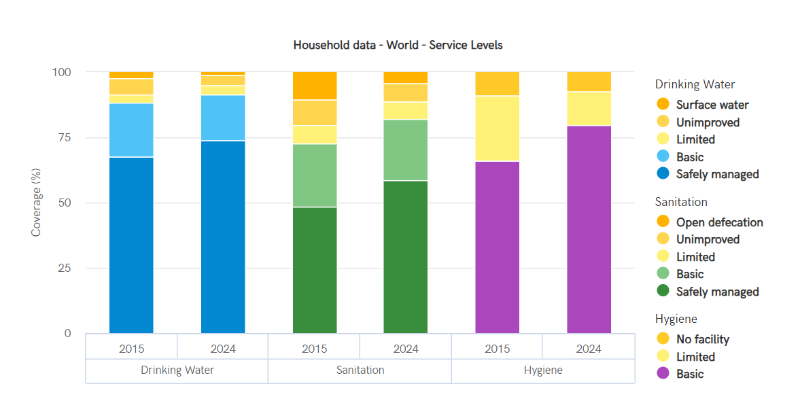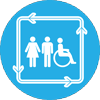- Forum
- categories
- Announcements and miscellaneous
- New publications (books, articles, websites, videos)
- New JMP progress report
New JMP progress report
561 views
Here is my sanitation-focused summary:
(originally shared here www.linkedin.com/posts/andr%C3%A9shueso_...645082742263811-pbif):
🚽 These are the overall numbers (all for 2024):
- 4.8 billion people have access to safely managed sanitation services
- 3.4 billion people lack safely managed sanitation services, including
* 1.9 billion with basic services (aka decent toilet, but waste untreated)
*560 million with limited services (aka shared toilets)
* 555 million with unimproved services (aka unhygienic toilet)
* 354 million practising open defecation.
🚽 There has been continued progress, but it is far too slow.
- Since 2015, 1.2 billion people have gained access to safely managed sanitation services, with coverage increasing from 48% to 58%.
- At this pace of progress, we’ll have to wait until 2063 to reach the SDG 6.2 ambition of universal access. A sixfold acceleration is needed (global average, but coincidentally also the acceleration needed in high-income countries).
🚽 Progress has been unequal between countries, regions, income groups, etc. For instance:
- Coverage in rural areas increased from 36% to 49% and in urban areas from 59% to 66%.
- The total population lacking safely managed sanitation has actually increased in low- income countries
- Open defecation in urban areas has been technically eliminated (<1%). [in my opinion this indicates how national statistics fail to fully capture the situation in informal settlements]
🚽 The report has new/more details on types and status of containment and emptying:
- More people use on-site sanitation (47%) than sewer connections (42%)
- Fewer than half of on-site sanitation users reported that waste had been emptied and removed off-site.
- Release of faecal waste from the containment into the environment is quite frequent; it affected between a quarter and a half of the containments in three of six countries with data. These are due to adverse events like collapse, flooding or overflowing, and highlights the importance of improving the quality and climate resilience of containments and pit emptying services.
(originally shared here www.linkedin.com/posts/andr%C3%A9shueso_...645082742263811-pbif):
🚽 These are the overall numbers (all for 2024):
- 4.8 billion people have access to safely managed sanitation services
- 3.4 billion people lack safely managed sanitation services, including
* 1.9 billion with basic services (aka decent toilet, but waste untreated)
*560 million with limited services (aka shared toilets)
* 555 million with unimproved services (aka unhygienic toilet)
* 354 million practising open defecation.
🚽 There has been continued progress, but it is far too slow.
- Since 2015, 1.2 billion people have gained access to safely managed sanitation services, with coverage increasing from 48% to 58%.
- At this pace of progress, we’ll have to wait until 2063 to reach the SDG 6.2 ambition of universal access. A sixfold acceleration is needed (global average, but coincidentally also the acceleration needed in high-income countries).
🚽 Progress has been unequal between countries, regions, income groups, etc. For instance:
- Coverage in rural areas increased from 36% to 49% and in urban areas from 59% to 66%.
- The total population lacking safely managed sanitation has actually increased in low- income countries
- Open defecation in urban areas has been technically eliminated (<1%). [in my opinion this indicates how national statistics fail to fully capture the situation in informal settlements]
🚽 The report has new/more details on types and status of containment and emptying:
- More people use on-site sanitation (47%) than sewer connections (42%)
- Fewer than half of on-site sanitation users reported that waste had been emptied and removed off-site.
- Release of faecal waste from the containment into the environment is quite frequent; it affected between a quarter and a half of the containments in three of six countries with data. These are due to adverse events like collapse, flooding or overflowing, and highlights the importance of improving the quality and climate resilience of containments and pit emptying services.
Andrés Hueso
Senior Policy Analyst – Sanitation
WaterAid
Follow me on Twitter @andreshuesoWA
Senior Policy Analyst – Sanitation
WaterAid
Follow me on Twitter @andreshuesoWA
Please Log in to join the conversation.
You need to login to reply- paresh
-
 Topic Author
Topic Author- Moderator
- Budding WASH researcher, especially interested in governance, public policy, finance, politics and social justice. Architect, Urban & Regional planner by training, Ex. C-WAS, India.I am a patient person :)
Less- Posts: 375
- Karma: 7
- Likes received: 141
Dear All,
Dave brought to my notice that a new progress report on household WASH, titled "Progress on household drinking water, sanitation and hygiene 2000-2024: special focus on inequalities", has been published. It can be accessed here .
Report highlights
Between 2000 and 2024, the global population rose from 6.2 to 8.2 billion. Over this period, about a quarter of the population (2.2 billion) gained access to safely managed drinking water and a third (2.8 billion) to safely managed sanitation. Yet progress has been uneven and the number of people left behind has fallen more slowly. Since 2015, the distribution of the unserved has shifted: the proportion of the population with sanitation services has risen quickly in rural areas while staying relatively flat in urban areas. However, in terms of raw numbers most of the gains have been realized in urban areas. Basic hygiene access has improved, especially in rural areas; and the share of people unserved has increasingly concentrated in low-income countries.
I encourage members to explore the data and share their findings. I am sure they will interest many.
Dave brought to my notice that a new progress report on household WASH, titled "Progress on household drinking water, sanitation and hygiene 2000-2024: special focus on inequalities", has been published. It can be accessed here .
Report highlights
Between 2000 and 2024, the global population rose from 6.2 to 8.2 billion. Over this period, about a quarter of the population (2.2 billion) gained access to safely managed drinking water and a third (2.8 billion) to safely managed sanitation. Yet progress has been uneven and the number of people left behind has fallen more slowly. Since 2015, the distribution of the unserved has shifted: the proportion of the population with sanitation services has risen quickly in rural areas while staying relatively flat in urban areas. However, in terms of raw numbers most of the gains have been realized in urban areas. Basic hygiene access has improved, especially in rural areas; and the share of people unserved has increasingly concentrated in low-income countries.
- Achieving the 2030 targets for safely managed services is increasingly out of reach
- The population without WASH services is declining except in urban areas and low-income countries
- Despite gains since 2015, 1 in 4 – or 2.1 billion people globally – still lack access to safely managed drinking water, including 106 million who drink directly from untreated surface sources
I encourage members to explore the data and share their findings. I am sure they will interest many.
Paresh Chhajed-Picha
Moderator, SuSanA forum
Project Manager at ADCPS
Indian Institute of Technology - Bombay, India
Moderator, SuSanA forum
Project Manager at ADCPS
Indian Institute of Technology - Bombay, India
Attachments:
-
 JMP2025_WASH.png
(Filesize: 58KB)
JMP2025_WASH.png
(Filesize: 58KB)
Please Log in to join the conversation.
You need to login to reply
Share this thread:
- Forum
- categories
- Announcements and miscellaneous
- New publications (books, articles, websites, videos)
- New JMP progress report
Recently active users. Who else has been active?
Time to create page: 0.064 seconds







